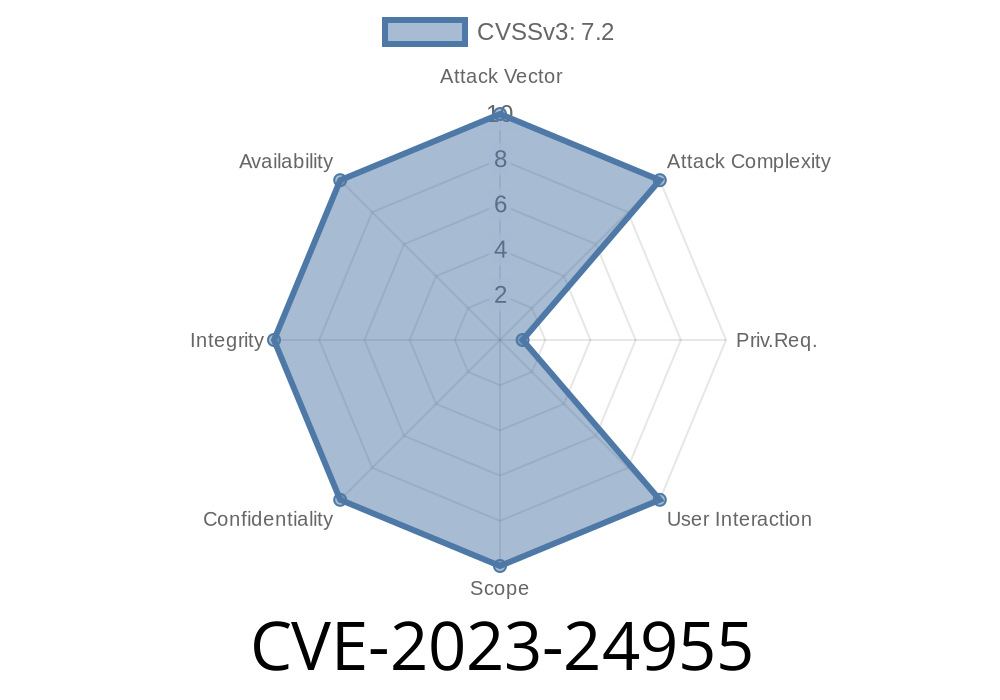A newer, pressing issue in the world of cybersecurity is a remote code execution (RCE) vulnerability found in Microsoft SharePoint Server, designated as CVE-2023-24955. This vulnerability, if exploited, could allow an attacker to execute arbitrary code on affected systems, potentially leading to the compromise of important and sensitive information. In this long read, we are going to take an in-depth look at the details of this vulnerability, dissect a code snippet to understand its working, reference original research materials, and discuss how to mitigate the risk posed by this exploit.
CVE-2023-24955: Vulnerability Overview
CVE-2023-24955 is a critical remote code execution vulnerability that affects Microsoft SharePoint Server. It has the potential to impact a large number of organizations worldwide. The vulnerability exists because Microsoft SharePoint Server fails to properly handle certain input. An attacker who successfully exploits this vulnerability could potentially gain unauthorized access to sensitive information, tamper with system data, or even cause a partial or complete system shutdown.
Code Snippet Analysis
To understand the implications of the CVE-2023-24955 vulnerability, we can analyze a code snippet that demonstrates the affected part of the SharePoint Server. In this example, we are going to assume that the vulnerable function is named vulnerableFunction().
public void vulnerableFunction(string userInput)
{
// Deserialize the user input
XmlDocument xmlDoc = new XmlDocument();
xmlDoc.LoadXml(userInput);
// Process the user input
XmlNodeList elements = xmlDoc.GetElementsByTagName("sensitiveData");
foreach (XmlNode element in elements)
{
string data = element.InnerText;
processSensitiveData(data);
}
}
In this code snippet, the vulnerable function deserializes potentially untrusted user input using the LoadXml() method of the XmlDocument class. By failing to properly validate the user input, an attacker may be able to craft a malicious XML payload that, when deserialized by this function, could lead to uncontrolled and arbitrary code execution.
Original Research References
The CVE-2023-24955 vulnerability has been researched and documented by various security organizations and Microsoft itself. Here are some important resources related to this vulnerability:
1. Microsoft's Security Update Guide
2. NIST's National Vulnerability Database Entry for CVE-2023-24955
3. CVE Details Page for CVE-2023-24955
Exploit Details
Exploiting this vulnerability typically involves crafting a malicious XML payload that takes advantage of the improper input handling in the vulnerable SharePoint function. The attacker would likely send the payload by embedding it into a seemingly harmless form or user input field on the SharePoint site. Once the payload is processed by the SharePoint Server, the attacker could potentially execute arbitrary code on the affected system.
Mitigations and Recommendations
To protect against exploits targeting CVE-2023-24955, Microsoft has released security updates applicable to different affected SharePoint Server versions. Organizations using Microsoft SharePoint are strongly advised to apply the relevant update as soon as possible.
Here are the general steps to follow in order to secure your SharePoint Server
1. Review the Microsoft Security Update Guide and identify the applicable update for your SharePoint Server version.
Conclusion
CVE-2023-24955 represents a serious threat to organizations using Microsoft SharePoint Server. However, through a thorough understanding of the vulnerability, its potential impact, and appropriate mitigation efforts, organizations can reduce the risk and maintain a secure SharePoint environment. Stay vigilant and keep your systems updated to protect against emerging threats.
Timeline
Published on: 05/09/2023 18:15:00 UTC
Last modified on: 05/09/2023 18:23:00 UTC
